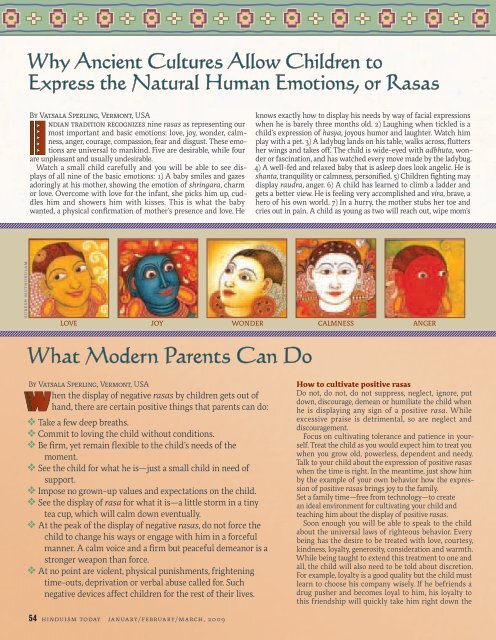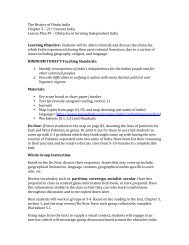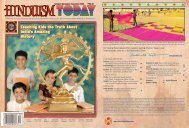Hinduism Today January 2009 - Cover, Index, Front Articles
Hinduism Today January 2009 - Cover, Index, Front Articles
Hinduism Today January 2009 - Cover, Index, Front Articles
You also want an ePaper? Increase the reach of your titles
YUMPU automatically turns print PDFs into web optimized ePapers that Google loves.
Why Ancient Cultures Allow Children toExpress the Natural Human Emotions, or RasasBy Vatsala Sperling, Vermont, USAIndian tradition recognizes nine rasas as representing ourmost important and basic emotions: love, joy, wonder, calmness,anger, courage, compassion, fear and dis gust. These emotionsare universal to mankind. Five are desirable, while fourare unpleasant and usually undesirable.Watch a small child carefully and you will be able to see displaysof all nine of the basic emotions: 1) A baby smiles and gazesadoringly at his mother, showing the emotion of shringara, charmor love. Overcome with love for the infant, she picks him up, cuddleshim and showers him with kisses. This is what the babywanted, a physical confirmation of mother’s presence and love. Heknows exactly how to display his needs by way of facial expressionswhen he is barely three months old. 2) Laughing when tickled is achild’s expression of hasya, joyous humor and laughter. Watch himplay with a pet. 3) A ladybug lands on his table, walks across, fluttersher wings and takes off. The child is wide-eyed with adbhuta, wonderor fascination, and has watched every move made by the ladybug.4) A well-fed and relaxed baby that is asleep does look angelic. He isshanta, tranquility or calmness, personified. 5) Children fighting maydisplay raudra, anger. 6) A child has learned to climb a ladder andgets a better view. He is feeling very accomplished and vira, brave, ahero of his own world. 7) In a hurry, the mother stubs her toe andcries out in pain. A child as young as two will reach out, wipe mom’stears and touch the injury in an expression of karuna, compassion,empathy or mercy. 8) A loud noise startles and wakens the baby andhe cries out in fear, bhayanaka. This cry is distinct from all othercries. 9) Try spooning a cooked and mashed vegetable into an infant’smouth. As he sniffs, tastes, spits out and makes a horrible face he isexpressing vibhatsa, disgust, with the new taste, very different fromthat of milk, his staple diet so far. Besides these, a child can displaywith equal ease and mastery a few more inherent emotions, such assadness, greed, selflessness, obstinacy, curiosity, clinginess, generosity,dependency, violence, arrogance and rudeness.The older, child-centered cultures take a different approach to thedisplay of rasas by the powerful beings called children. The parentingtechniques followed in many so-called primitive cultures fosterattachment, and create such a closeness and bond between motherand child that the mother develops a total acceptance and understandingof her child and his mind. When an entire extended familylives in a one-room longhouse in the rain forest of South America,the adults reach a high level of tolerance to childhood display of rasas.They do not expect the child to conform to the expectations ofthe adults the moment he opens his eyes to this world. Disciplineand assimilation into the community will come later, by way of numerousrites of passage.In a similar fashion, the child-centered and ancient culture of Indiatakes a very tolerant view of the childhood display of rasas. InIndia they let the children be children. They understand that childhooddoes not last forever. Soon enough the child will grow up andlearn the ways of the world. There is no need to rush the process, tocause premature aging and untimely maturation.When children have strong emotions, the adults do not feel theneed to resort to violent beatings or verbal abuse to suppress the expressionthose feelings. Such a response would only inflict rejectionand social humiliation on children for their natural displays. Adultsin these older cultures understand that just as a lion hunts a deer, thechild, in all his innocence, is simply following his inborn instincts. Heis not acting to please or displease. These adults understand that justas nature expresses herself through her elements, children expressthemselves through their displays of rasas. The display is not the child.It is just a state of mind and therefore is inherently changeable. ∏πsuresh muthukulamLove Joy Wonder Calmness Anger Courage Compassion Fear DisgustNine innate emotions:1) Shringara, love, devotion;2) hasya, joy, humor; 3) adbhuta,wonder, curiosity; 4) shanta,calmness; 5) raudra, anger;irritation; 6) vira, courage;7) karuna, compassion,empathy; 8) bhayanaka, fear,anxiety; 9) vibhatsa, disgustWhat Modern Parents Can DoBy Vatsala Sperling, Vermont, USAWhen the display of negative rasas by children gets out ofhand, there are certain positive things that parents can do:❖ Take a few deep breaths.❖ Commit to loving the child without conditions.❖ Be firm, yet remain flexible to the child’s needs of themoment.❖ See the child for what he is—just a small child in need ofsupport.❖ Impose no grown-up values and expectations on the child.❖ See the display of rasa for what it is—a little storm in a tinytea cup, which will calm down eventually.❖ At the peak of the display of negative rasas, do not force thechild to change his ways or engage with him in a forcefulmanner. A calm voice and a firm but peaceful demeanor is astronger weapon than force.❖ At no point are violent, physical punishments, frighteningtime-outs, deprivation or verbal abuse called for. Suchnegative devices affect children for the rest of their lives.How to cultivate positive rasasDo not, do not, do not suppress, neglect, ignore, putdown, discourage, demean or humiliate the child whenhe is displaying any sign of a positive rasa. Whileexcessive praise is detrimental, so are neglect anddiscouragement.Focus on cultivating tolerance and patience in yourself.Treat the child as you would expect him to treat youwhen you grow old, powerless, dependent and needy.Talk to your child about the expression of positive rasaswhen the time is right. In the meantime, just show himby the example of your own behavior how the expressionof positive rasas brings joy to the family.Set a family time—free from technology—to createan ideal environment for cultivating your child andteaching him about the display of positive rasas.Soon enough you will be able to speak to the childabout the universal laws of righteous behavior. Everybeing has the desire to be treated with love, courtesy,kindness, loyalty, generosity, consideration and warmth.While being taught to extend this treatment to one andall, the child will also need to be told about discretion.For example, loyalty is a good quality but the child mustlearn to choose his company wisely. If he befriends adrug pusher and becomes loyal to him, his loyalty tothis friendship will quickly take him right down thedrain and into the septic tank. This is wherediscretion comes in.When all is said and done, nobody candeny that these are challenging times forparents. Rootlessness, alienation, marginalizationand anonymity—these are someof the prices parents pay when they movearound the world in search of the perfect situation.Young parents are often cut off fromtheir original cultures and societies. Technocommercialvalues constantly push parentsand children to test one another. In pursuitof their individual ambitions and needs,parents and children often live in separateworlds, albeit in the same household. Andwhen children enter school, the child whohas not been given time to be a child, whohas not been accepted with tolerance, oftenends up in the school nurse’s office beingtested for and diagnosed with illnesses suchas bipolar disorder, ADHD or oppositionaldefiant disorder.Harried teachers, under pressure to maintainorder in their classrooms and to havetheir students meet minimum academicstandards, expect all of the children to behavelike obedient, quiet, perfect little ladiesand gentlemen. Children are not allowed tobe children. They are not allowed to deviatefrom the norm or to freely express all oftheir rasas.Sometimes as early as the age of three orfour, children are labeled with psychiatricdiagnoses and begin to be treated withpowerful drugs such as lithium or Depakote(mood stabilizers), Risperdal, Seroquel orZyprexa (atypical antipsychotics), Prozac (anantidepressant) or Ritalin (a drug for ADHD).Each of these drugs comes with a frighteninglist of side effects. If prescribed withoutany physical markers, but solely on the basisof behavior—or rather the display of rasas—what good (or harm) is being done to thechild, the parents and society?In the face of this, it becomes all the moreimperative that parents consider other, moreholistic approaches to child rearing. If, as issometimes the case, the child’s display ofrasas becomes detrimental to his own orhis family’s well-being, there are scores ofother, non-pharmaceutical options availablefor modifying mood and behavior. Hisparents might explore changing his diet,limiting his intake of sugar, preservativesand additives. Calming and healing herbsmight help. Perhaps homeopathy could shifthis energetic balance, or counseling for theentire family could diffuse the situation.Training a child in classical music, classicaldance or martial arts could help. All ofthese disciplines have been known to stabilizeand channel excessive or disruptiveenergy in more positive directions. A regulartime, free of TV, when family members sittogether, work together and converse withone another is also known to provide lasting,positive change for children.As children grow up and display rasas,parents need to continue to grow up aswell—not just in the physical manifestationsof age, the wrinkles and gray hair, but inwisdom. This is what a study of the displayof rasas in childhood is all about: a call forparents to monitor the growth of their wisdom.When parents learn to take charge oftheir own growth in terms of tolerance andempathy and resolve to let children be childrenfirst, allowing them an age-appropriatedisplay of rasas, they have an opportunityto become truly close to their children andknow them in their totality. As children mature,good parents take the initiative for gentlychanneling their rasas at the appropriatetime and place. When parents take this positiveapproach to child-rearing, the optionsof violent discipline and drug-based treatmentsbecome obsolete. While we continueto ponder who is raising whom, learning toflow with the rasas will bring about lastingpeace and joy in many households.54 hinduism today january/february/march, <strong>2009</strong> january/february/march, <strong>2009</strong> hinduism today 55
















